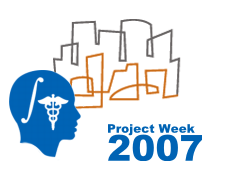Difference between revisions of "Projects/Diffusion/2007 Project Week EPI Distortion correction using field maps"
| Line 24: | Line 24: | ||
<h1>Approach, Plan</h1> | <h1>Approach, Plan</h1> | ||
| + | |||
| + | In the series of field mapping, we acquired two sets of images with different TEs (9 and 15 ms). In each set, we have real images, imaginary images, and magnitude images for each slice location. Therefore, total number of images in the series is 2*3*85. We have one dataset that includes sMRI, DTI and fMRI, and need help with distortion correction. | ||
| + | |||
| + | |||
| + | </div> | ||
| + | |||
| + | <div style="width: 40%; float: left;"> | ||
| + | |||
| + | <h1>Progress</h1> | ||
| + | |||
| + | </div> | ||
| + | |||
| + | <br style="clear: both;" /> | ||
| + | |||
| + | </div> | ||
Revision as of 23:51, 23 June 2007
Home < Projects < Diffusion < 2007 Project Week EPI Distortion correction using field maps Return to Project Week Main Page |
Key Investigators
- BWH: Marek Kubicki
- Anyone else who is interesting in helping
Objective
EPI data collected for DTI and fMRI analysis are spatially distorted, due to susceptibility/chemical shift artifacts. Our VCFS pilot data have been collected using parallel imaging, which reduces distortions, but does not eliminate them. In our data, we see artifacts in the inferior temporal and inferior frontal brain regions. As suggested by Bruce Fischl at the last Core1 meeting, we collected field maps to calculate distortions, which information could be then used to "undistort" images.
Approach, Plan
In the series of field mapping, we acquired two sets of images with different TEs (9 and 15 ms). In each set, we have real images, imaginary images, and magnitude images for each slice location. Therefore, total number of images in the series is 2*3*85. We have one dataset that includes sMRI, DTI and fMRI, and need help with distortion correction.
Progress